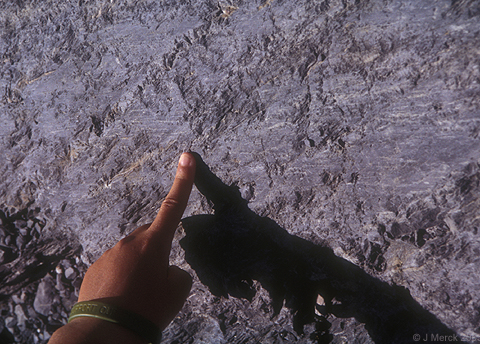Outcrop du jour: Context, Image 1, Image 2, Image 3, Image 4, Image 5.
Terrestrial sedimentary environments V - Glacial
Glacial environments

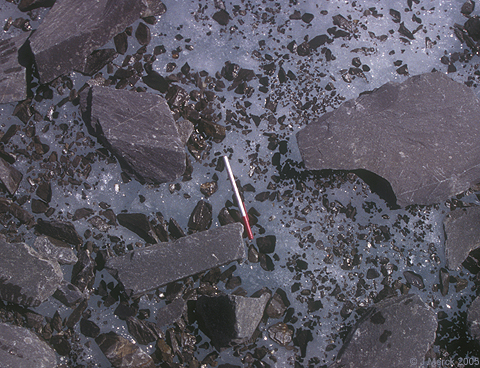
- Bulldozing: Unlike water or wind, glacial ice can push very large clasts along.
- Plucking: For reasons of fluid dynamics, glaciers tend to pull up pieces of bedrock from their beds as they flow.
- Abrasion: Lots of rock gets caught up in the boundary layer of ice next to the glacier's bed. As a result, the glacier acts like megasandpaper.
- Any material that has been brought to the glacier by mass wasting is indiscriminantly transported by the glacier.
- Striations: as pieces of rock are dragged over bedrock
this creates smooth, abraded surfaces. Striations reveal the direction of flow. In the case of continental glaciations, scoured surfaces can be continental in scale.

- Roche moutonnee: The glacial equivalent of a yardang. Piece of bedrock carved by a glacier. Typically, the upstream side will be smoothly abrades but the downstream side will be jagged, with pieces plucked out.
Erosional land forms that form from valley glaciers: These are what we think of as the typical features of regions like the Alps and high mountains of western North America. They may be occupied by active glaciers or may be left over when the glacier melts.- Glacial valleys: have a distinctive "U" shape (whereas running water makes a "V"). Glacial valleys are deep, wide and straight.

- Hanging valleys: Remember the ideal longitudinal profiles of streams. Because of these, tributaries of larger rivers tend to be at the same elevation when they flow together. This isn't so with glaciers. With them, usually, tributary glaciers empty into main valleys high up on the valley walls. Indeed, some of the world's best waterfalls are formed by streams flowing through former glacial tributaries.
- Cirques: Amphitheater-like hollow in which glacier first accumulates. After glacier melts, floor of cirques are often occupied by tarns [Old Norse Tjörn - "pond"] - little cold lakes.
- The interaction of adjacent glacial valleys produces distinctive features:
- Fjords: [Old Norse Fjörðr - "ferry crossing," "ford"] - Submerged glacial valleys that appear as deep narrow bays.
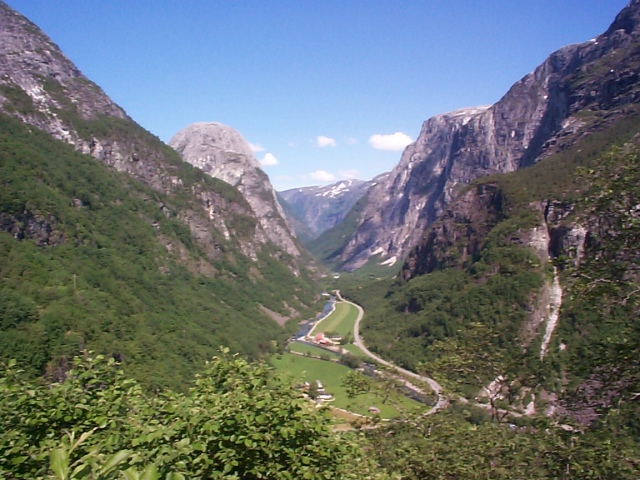
- Drift: Glacial sediments is called drift- consists of:
- till: Glacially transported sediment that is:
- Utterly unsorted
- Can have any composition but is usually lithic fragments
- Deposited by the glacier.
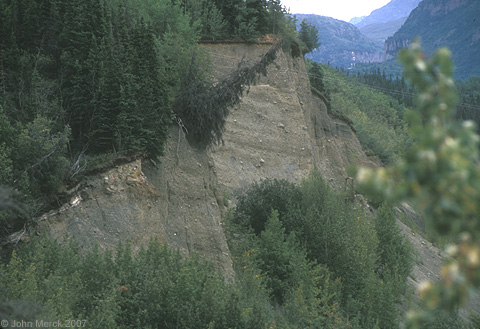
- Stratified drift: bedded glacial material that has been secondarily redeposited by water in outwash streams.
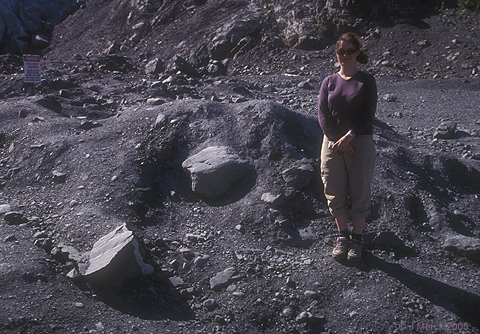
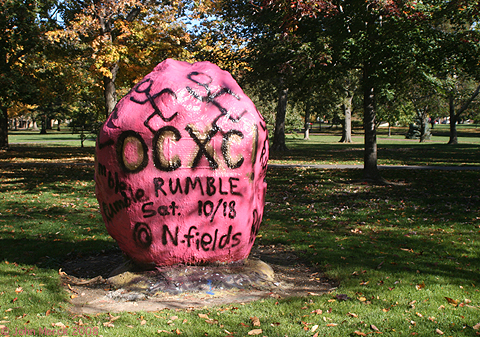
- till: Glacially transported sediment that is:
- Erratics: Glaciers can deposit house sized clasts that later seem like huge rocks from nowhere, with lithologies inappropriate to their settings.

- Moraines: Land forms that are composed of glacial till. The type of moraine depends on where the till was deposited with respect to the glacier:
- End moraine - pile of sediment that is deposited at the end of a glacier. Three types:
- Terminal moraine - farthest extent
- Ground moraine - layer of sediment deposited as glacier retreats
- Recessional moraine - end moraine deposited uphill of terminal moraines as glacier halts in recession (Q: How do we know it wasn't deposited first???)
- Lateral moraine - at edges of glacier
- Medial moraine - two laterals from tributary.
- End moraine - pile of sediment that is deposited at the end of a glacier. Three types:
Such moraines remain prominent features of the landscape long after the glacier is gone but note: They only preserve the most recent glacier at a given spot. Earier remains would have been bulldozed away by newer glaciers.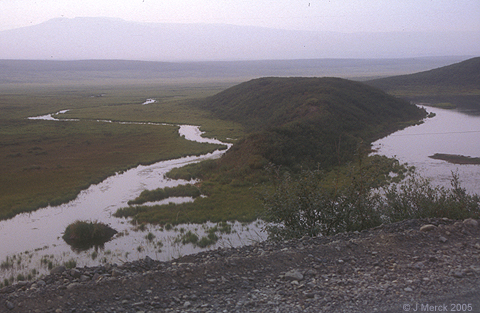
Associated fresh water environments
Outwash streams reworking till into stratified drift. E.G. the source of the Matanuska river at the Matanuska glacier, AK, right)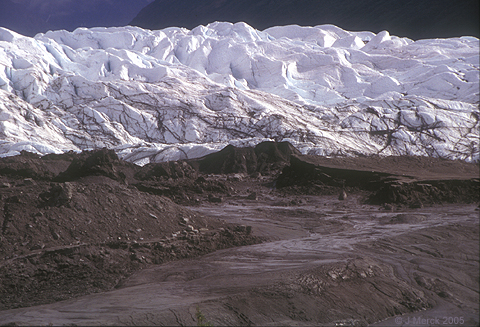
Proglacial lakes: Lakes of meltwater impounded by moraine or glacial ice. These result in the deposition of pockets of lacustrine and associated sediments, including small deltas, laminated lake deposits and dropstones. E.G. Jöküllsárlón, Iceland, right)
Glacial deposits in the rock record:
- Only the record of retreating glaciers
- The speed of glacial retreat
- The relative contribution of glacial tills and sediments of associated environments.
Q: Can glacial deposits ever result from a prograding glacial environment?
Land forms resulting from continental glaciers: Continental scale glaciation creates interesting opportunities for ice to interact with large volumes of sediment. Results include:
- Drumlin: Hills made of reshaped glacial till (not bedrock like a roche moutonee.
- The steep end is on the side of the ice's approach
- The shallow end points in the direction of ice movement

- Kame [Scots"comb." Pronounced like English "came"]: Hills of stratified drift that form when a stream deposits sediment in a hole in the glacial ice.
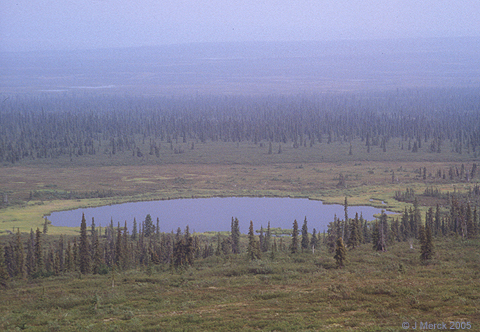

- Kettle lake: This is essentially the opposite of a kame. When a block of glacial ice is stranded by a retreating glacier, it prevents sediments from being deposited. When if finally melts, a depression is left that fills with water. Think of Minnesota - the land of 1000 lakes. These lakes are mostly kettles formed during the retreat of a continental ice sheet.


- Esker [Irish Eiscir - "ridge"]: Long sinuous ridge of stratified drift. Results from sediment deposited by under-glacier stream.

- Roche moutonnee: The glacial equivalent of a yardang. Piece of bedrock carved by a glacier. Typically, the upstream side will be smoothly abrades but the downstream side will be jagged, with pieces plucked out.
